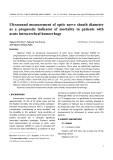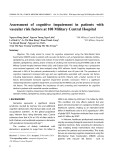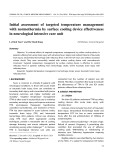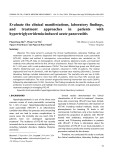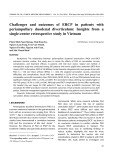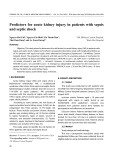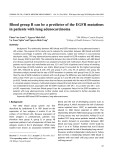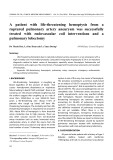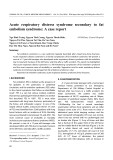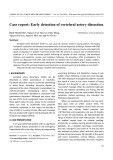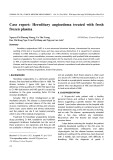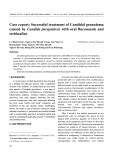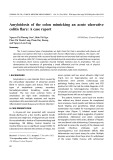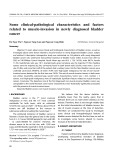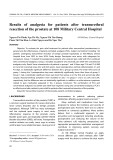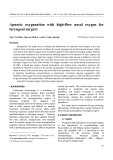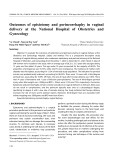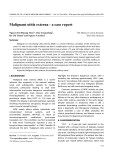
HUE JOURNAL OF MEDICINE AND PHARMACY ISSN 3030-4318; eISSN: 3030-4326HUE JOURNAL OF MEDICINE AND PHARMACY ISSN 3030-4318; eISSN: 3030-4326
128 129
Hue Journal of Medicine and Pharmacy, Volume 15, No.2/2025 Hue Journal of Medicine and Pharmacy, Volume 15, No.2/2025
A comparison of the effects of two types of periodontal dressings with and
without zinc oxide on non-surgical periodontal treatment
Nguyen Thi Thuy Duong1*, Tran Khanh Hung
Faculty of Odonto-stomatology, University of Medicine and Pharmacy, Hue University
Abstract
Background: Periodontal dressings have recently become an important research topic in periodontal
treatment. Periodontal dressings have also proven effective in supporting non-surgical mechanical therapy
for short-term clinical outcomes. Objective: This study evaluated the effects of two types of periodontal
dressings, with and without zinc oxide, on non-surgical periodontal treatment. Materials and Methods:
This randomized controlled trial, with a split-mouth design, was conducted on 31 patients with stage II-
III periodontitis (AAP/EFP 2017). After scaling and root planing, two types of periodontal dressings were
applied in opposite sextant regions. Clinical periodontal indices were assessed at baseline and 1 week, 1
month, 3 months, and 6 months after treatment. Radiographs were obtained at baseline and 6 months
after treatment. Results: After treatment, the plaque index (PlI), bleeding on probing index (BOP), probing
pocket depth (PPD), and clinical attachment level (CAL) in both groups were significantly reduced compared
with baseline values. The periodontal dressing without zinc oxide showed higher effects than periodontal
dressing with zinc oxide in terms of changes in the gingival index (GI), PPD, and CAL. Conclusion: Periodontal
dressings, especially without zinc oxide, support clinical improvement in stage II-III periodontitis through
non-surgical therapy.
Keywords: periodontitis, non-surgical periodontal treatment, periodontal dressing.
*Corresponding Author: Nguyen Thi Thuy Duong. Email: nttduong@huemed-univ.edu.vn
Received: 5/11/2024; Accepted: 10/3/2025; Published: 28/4/2025
DOI: 10.34071/jmp.2025.2.19
1. INTRODUCTION
Periodontitis is one of the most common
diseases affecting the oral cavity. It is important to
treat the disease promptly, as it not only results in
tooth loss, but also affects the general health of
the patient [1]. In the treatment of periodontitis,
non-surgical therapy with scaling and root planing
(SRP) has become the “gold standard”[2]. To
support and increase the effectiveness of non-
surgical mechanical therapy, periodontal dressings
have been suggested to protect the treatment
area and create pressure on the treatment area,
thereby helping the periodontal tissue adapt to
the underlying structure, providing better stability,
preventing the invasion of bacteria, and improving
clinical parameters [3-7].
Since 1923, several types of periodontal
dressings have been developed and researched.
However, there is still debate regarding the need to
select the most suitable type for clinical application.
Coe-Pak (GC, USA) is one of the most widely used
dressings containing zinc oxide. It is based on a
metallic oxide and fatty acid reaction; however, it
has some disadvantages, including inappropriate
setting time and poor flowability. Coe-pak was
reported to cause bacterial and plaque accumulation
at the site of surgery, which can delay post-surgical
wound healing [8], [9]. A zinc oxide non-containing
dressing, Reso-pac (Hager and Werken GmbH and
Co., Germany), is a soft, soluble, and hydrophilic
dressing with the ability to adhere to oral tissues,
facilitating easy coverage and protection of the
wound. In addition to being the main component
of cellulose, Reso-pac contains myrrh, which has
disinfectant, adhesive, and hemostatic properties.
This dressing material resulted in fibrin formation
in wounds. Reso-pac has also been reported to
have pleasant taste and elastic properties, which
relieve wounds from excessive tension [8].
Recently, there have been many publications
on the effectiveness of periodontal dressing in non-
surgical treatment, such as that by Sigusch et al.
(2005), Genovesi et al. (2012), Keestra et al. (2014),
Monje et al. (2016) [3, 5-7]. The results of the above
studies showed significant clinical improvement
when using periodontal dressing; however, each
study used a different type of periodontal dressing,
and there was no comparison of the effectiveness
of Coe-pak and Reso-pac periodontal dressings. In
Vietnam, there are currently no studies on the effects
of periodontal dressings on periodontitis treatment.
Therefore, to better understand the effectiveness
of periodontal dressing in non-surgical treatment,
we conducted this study to compare the results of





